Key Takeaways
- A survey of higher education institutions in a 12-state region investigated how they support faculty with the design and development of web-based classes.
- The literature on best practices guided the creation of the web-based survey questions, which targeted the chief academic affairs officers on each campus or the appropriate delegate.
- The study found that institutions offer a variety of support services to online faculty, such as requiring training prior to teaching online and including web-based learning in institutional goals and strategic plans.
- The next step implied by the study findings is for institutions to look at strategies that influence the desired behavior changes among faculty to use the institutional support mechanisms provided.
With continued advances in web-based learning, colleges and universities strive to meet the needs and interests of students, faculty, and staff. New instructional technologies have at least one thing in common: the learning curve associated with users becoming adept. Mastery requires significant time and attention.
Providing the best quality experiences in a web-based learning environment, including but not limited to learning, requires attention not only to the best practices and newest technologies but also to how institutions support and prepare faculty to accomplish such tasks. This article reports findings from a recent study we conducted that looked at how institutions support faculty with the design and development of web-based classes. The compiled findings provide some insight as to how institutions view online learning and how they support faculty in preparing to deliver online classes. This information may help individual institutions determine where they stand relative to other institutions and their own goals.
Ann Taylor and Carol McQuiggan's 2008 article in EQ identified several of the support mechanisms online faculty desire, such as assistance with "converting course materials for online use" and "facilitating online discussion forums" as well as additional less-formal and self-paced learning materials.1 Our study's findings touch on some of Taylor and McQuiggan's findings, which we consider variables or factors affecting faculty success in the web-based classroom. A few of the many other factors that can affect the design, development, and success of a web-based course include online learner needs,2 the nurturing of community,3 highly interactive environments,4 and classroom climate.5
Research Design
Our study looked at provisions of institutional support for web-based classes in a major region of the United States. We identified 12 states in the region and from them selected 364 institutions of higher education. The main criterion used in identifying participating institutions was that they, at a minimum, offer bachelor's degrees. For institutions that, according to their Carnegie Classification, had several satellite campuses, we chose to include only the home campus in an effort to be more conservative with the sample and minimize validity issues (avoiding multi-counting under the same institutional profile). Of the initial campuses selected, 98 participated in the survey for a participation rate of 27 percent. Of those who began the survey, 86 completed the entire survey, with 74 of those institutions offering web-based courses.
The survey targeted chief academic affairs officers on the respective campuses. In instances where the chief academic officers felt they were not the best people to respond, they passed the survey on to more qualified respondents.
The literature on best practices guided our creation of the survey questions. The web-based survey featured a quantitative design and a five-point Likert scale. Questions were grouped together according to common themes. The findings in this article are organized according to those themes:
- "Demographics" contains general demographic information about the institutions surveyed, such as size of the institutions, types of institutions, and some basic information about the availability of web-based classes and programs.
- "Institutional Attitudes and Perspectives" examines attitudes and perspectives as they relate to the role web-based learning plays within the institution. For example, an increasing number of institutions specifically include web-based learning as part of their strategic plans.6 This section also includes institutional responses on the requirement that faculty receive training prior to teaching online.
- "Institutional Guidance" looks at the types of information institutions make available to faculty in the form of policies or expectations, which play an important role in improving human performance.7 Policies, for example, provide key information that could influence how faculty proceed with the design and development of a web-based class or web-based instructional materials. While some institutions require specific steps in the design process, others simply make materials available to assist faculty.
- "Institutional Tools" refers to the resources made available to further assist faculty with the actual design and development of web-based learning materials. It differs from institutional guidance, which more directly relates to institutional rules and policies that might influence behavior. The tools section features such provisions of support as self-directed learning modules and checklists.
- "Institutional Incentives" looks at decisions an institution might make to entice faculty to teach web-based courses. The literature has demonstrated concerns — such as its time-consuming nature — associated with moving to the online medium.8 If moving more faculty into web-based courses is an institutional priority, institutions may consider using different types of incentives to further increase the desirability of teaching web-based classes. Incentives could be monetary, but that is rarely the case within higher education.
Results and Interpretation
The study findings may help instructional design offices (and other groups tasked with providing assistance to faculty teaching web-based courses) determine where they stand relative to the sample. The research was partially intended to serve as a benchmarking tool, with the survey questions reflecting the instructional technology literature. Use of instructor competencies,9 self-evaluation/checklists,10 and institutional adoption of guidelines to help assure the course meets desired institutional standards11 — recurring themes in the literature — provided the foundation of the survey question design.
The study primarily used the following five-point Likert scale: strongly agree = 5, agree = 4, neither agree nor disagree = 3, disagree = 2, and strongly disagree = 1. The weighted scale was necessary to conduct various statistical analyses.
Demographics
Table 1 shows the demographic information for the study participants, providing context and understanding of who participated in the study. A review of the demographics shows that the majority of the institutions surveyed offer online classes, and half offer online degrees. In general, statistical tests comparing institutions that offer complete degrees online to those who do not indicated that the former held web-based learning in higher regard, offered greater support and guidance for faculty teaching web-based courses, and provided more tools and incentive to faculty teaching web-based courses.
Table 1. Institutional Demographics
| Institution Type | Public | 23 | 25.0% | N = 92 |
| Private | 69 | 75.0% | ||
| Institution Description (Private)* | Very small | 14 | 15.2% | N = 92 |
| Small | 38 | 41.3% | ||
| Medium | 16 | 17.4% | ||
| Large | 1 | 1.1% | ||
| Institution Description (Public)* | Very small | 1 | 1.1% | |
| Small | 7 | 7.6% | ||
| Medium | 11 | 12.0% | ||
| Large | 4 | 4.3% | ||
| Location | Rural | 49 | 53.3% | N = 92 |
| Urban | 43 | 46.7% | ||
| Offers Online Courses | Yes | 78 | 84.8% | N = 92 |
| No | 14 | 15.2% | ||
| Offers Complete Degrees Online | Yes | 37 | 50.0% | N = 74 |
| No | 37 | 50.0% |
* Self-selected; no criteria made available
Institutional Attitudes and Perspectives
We collected institutional attitudes and perspectives to gain an idea of where institutions stand with regard to web-based learning, as shown in Table 2 and Figure 1. This table and figure indicate that convenience to students and improving access to higher education stand as particular strengths of web-based learning, with over half of the respondents to each of these questions indicating agreement or strong agreement. We ran statistical tests to compare institutions on various demographics with regard to these variables and found that respondents at public institutions tend to agree more strongly that web-based learning is more convenient to students and that web-based learning improves access to higher education.
Table 2. Survey Questions 1 Through 4 on Institutional Attitudes
| Web-based courses… | Mean | SD |
| Q1. …are more convenient to students. | 4.34 | 0.727 |
| Q2. …improve access to higher education. | 4.24 | 0.888 |
| Q3. …can alleviate pressures on physical space. | 3.27 | 1.011 |
| Q4. …provide a revenue-generating opportunity. | 3.61 | 1.096 |

Figure 1. Institutional Attitudes Towards Web-Based Learning
Figure 2 demonstrates the findings when institutions were asked if they required adjunct, full-time nontenured and full-time tenured faculty to undergo training prior to teaching web-based courses. The results for this question indicate that the majority of institutions require online faculty to undergo at least some training. One respondent stated that "faculty have great latitude in the design of their courses"; however, we were not able to determine if they did in fact still require a certain level of preparation before faculty taught web-based classes. The emergence of web-based learning and the resultant requirements and expectations of faculty concerning course design can challenge that very latitude.
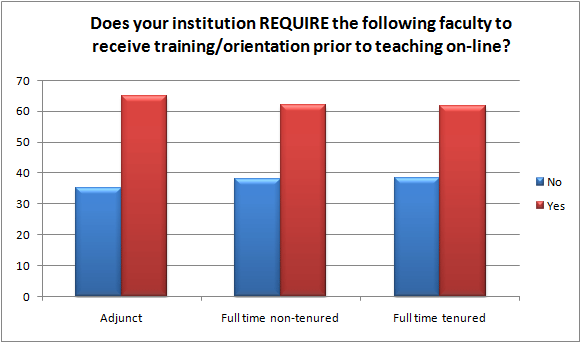
Figure 2. Faculty Must Undergo Some Training Prior to Teaching
Figures 3 and 4 look at institutional views of the role web-based learning plays in the overall institutional operation. This data supports the notion that web-based learning is generally accepted and continues to become more integral to institutional identity. This looks promising for the future of online education, since items that appear as institutional goals and/or on strategic plans often receive greater attention and support; over 60 percent of respondents agreed or strongly agreed that web-based learning fell into this category.
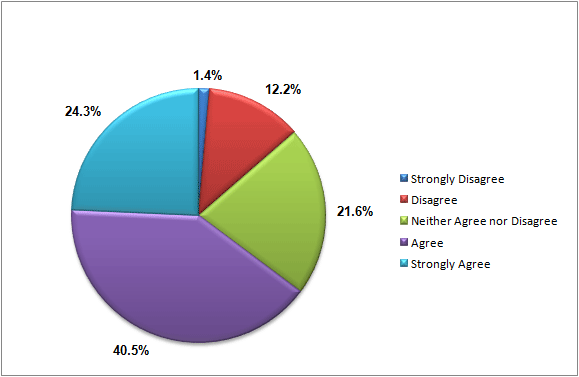
Figure 3. Web-Based Courses Help Fulfill Institutional Goals
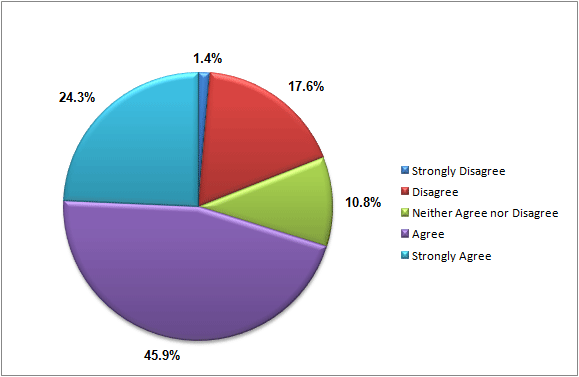
Figure 4. Web-Based Learning Is Specified in the Strategic Plan
Figure 5 demonstrates that institutions are making efforts to support web-based learning — over 80 percent either agree or strongly agree that they offer some level of support. Despite differences between the types and availability of support (for example, some institutions only offer technical training, whereas others offer technical and pedagogical training), at the very least the survey results begin to address the question of whether institutions are, collectively, taking steps to support faculty preparation for teaching web-based courses. However, the results do not indicate whether faculty use such services. Further statistical tests showed that public institutions generally offered instructional support services more than did private institutions.
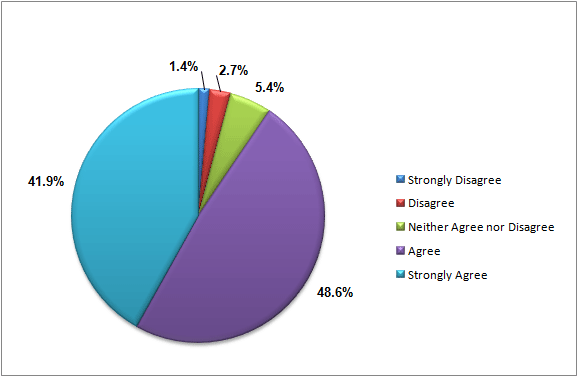
Figure 5. Institution Offers Instructional Support for Online Faculty
The following sections take this general response on providing institutional support and attempt to extrapolate further information about the nature of the support provided.
Institutional Guidance
The institutional guidance survey questions looked at the different mechanisms that might exist to help faculty develop web-based courses and, in some instances, web-based courses consistent with institutional goals or requirements. These provisions of support often serve as helpful starting points. They may serve as a guide to help steer faculty, especially faculty new to teaching web-based courses, in a direction consistent with institutional quality standards, not to mention saving them time in the process. Table 3 and Figure 6 demonstrate how institutions provide guidance to their faculty. On the whole, with the exception of collecting student feedback, we do not see a high degree of institutional guidance; only about half of the respondents indicated agreement or strong agreement to these institutional guidance questions. Note that question 11 is negatively worded, thus the results from this question appear consistent with the results from the other questions addressing institutional guidance.
Table 3. Questions 9 Through 12 on Institutional Guidance
| The institution… | Mean | SD |
| Q9. …provides expectations or guidelines to assist faculty with course design. | 3.76 | 1.180 |
| Q10. …provides course design requirements. | 3.36 | 1.234 |
| Q11. …has not identified instructional competencies. | 2.73 | 1.138 |
| Q12. …collects student feedback regarding the web-based learning environment. | 4.27 | 0.727 |

Figure 6. Institutional Guidance
Institutional Tools
The Institutional Tools section of the study looked at particular resources as opposed to policies or rules that may govern the design process. The questions in the tools section targeted a few of the ways institutions might assist faculty with the design and development of web-based courses. As Taylor and McQuiggan identified in their study, faculty strongly desire the presence of tools because tools provide the opportunity for faculty to learn at their own pace, regardless of when or where a training session might be offered.12 Table 4 and Figure 7 contain the findings for questions that relate to the availability of such tools. Question 14 is negatively worded and is consistent with the other questions in showing that fewer than half of respondents agreed that their respective institutions use these institutional tools. Additional tests (not shown here) suggested that public institutions generally made these tools available more than did private institutions.
Table 4. Questions 13 Through 15 on Institutional Tools
| The institution… | Mean | SD |
| Q13. …provides job aids/tools to assist with course development. | 3.49 | 1.100 |
| Q14. …does not offer online learning modules for self-directed study. | 2.81 | 1.158 |
| Q15. …adopted/developed self-evaluation tools to assist with the development of online courses. | 3.31 | 1.096 |
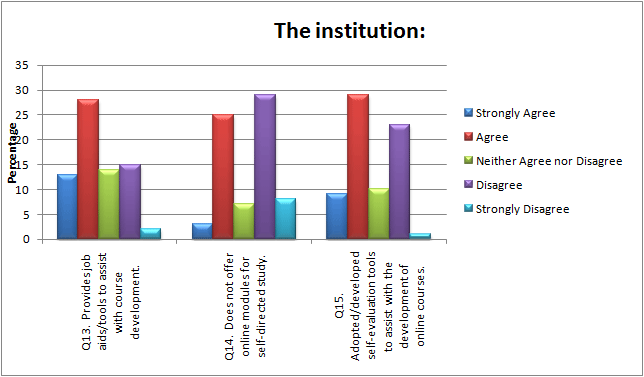
Figure 7. Institutional tools
Institutional Incentives
Just as tools can help faculty better prepare to teach online, incentives may encourage faculty to try teaching web-based courses. When certain tasks or initiatives rise to a threshold level of significance, incentives might emerge as ways to entice, encourage, or recognize and reward desired performance. While many often think of monetary incentives, non-monetary incentives are more common in higher education. Recognition and increased opportunities to assist others (mentoring, for example) offer simple and cost-effective ways that institutions choose to recognize their faculty.
Table 5 and Figure 8 demonstrate the findings related to incentives. The results generally indicate that the only incentive (of the ones we asked about) the sample institutions clearly use is that of providing opportunities for faculty to mentor or train other faculty. Faculty teaching web-based courses do not generally seem to be compensated at a higher rate, and they do not have opportunities for special recognition at the institutions surveyed.
Table 5. Questions 16 though 18 on Institutional Incentives
| The institution… | Mean | SD |
| Q16. …does not provide opportunities for recognition for online performance. | 3.21 | 1.074 |
| Q17. …compensates faculty at the same rate as teaching a face-to-face course. | 3.81 | 1.030 |
| Q18. …provides opportunities for faculty to mentor or train other faculty. | 3.82 | .793 |
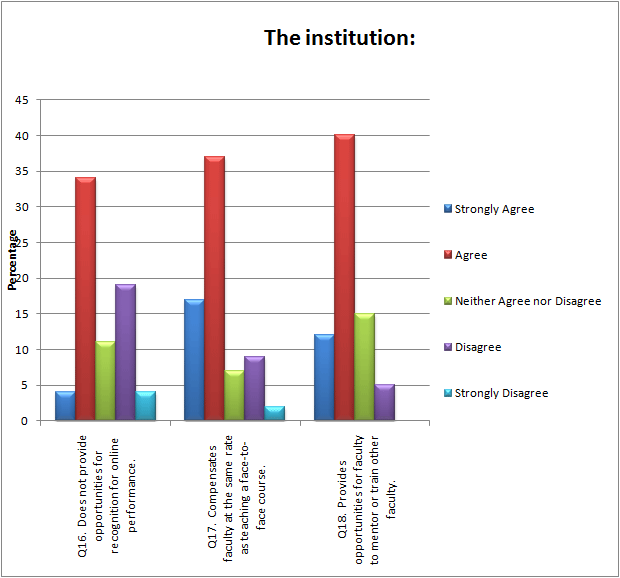
Figure 8. Institutional Incentives
Discussion
The Results and Interpretations section of the study provides an overview of how institutions are responding to the need to prepare faculty to teach web-based courses. Of the five sections addressed, Institutional Guidance, Institutional Tools, and Institutional Incentives provide the most actionable items, as they are based on actual best practices found within the literature. While the vast majority of institutions indicated they provide some level of instructional support for faculty teaching web-based courses, how they go about accomplishing that could vary considerably. For example, one respondent indicated that their campus does not have an instructional support services office to assist faculty with web-based instruction; instead, they contract outside services.
To better understand how the findings and their respective categories might relate to other institutions, the Discussion is broken down according to these three categories (Institutional Guidance, Institutional Tools, and Institutional Incentives).
Institutional Guidance
As noted, the institutional guidance questions looked at the different mechanisms that might exist to help faculty develop web-based courses, such as providing structure to the course development process. The study examined institutional expectations or guidelines, design requirements, the use of instructor competencies, and the presence of feedback specifically from the students' perspective. All of these pieces typically are developed based on criteria the institution has selected, which themselves evolve from decisions an institution has made with regard to how web-based classes should take place or what they should accomplish. While some institutions may be more stringent with their expectations and requirements, others can greatly benefit from simply adopting a preferred or recommended model approach. Such an approach provides faculty with guidance on recommended practices developed either in-house or as a collection from other sources. The instructional development and instructional technology literature, as well as organizations like The Sloan Consortium, are valuable sources of information.
The process of creating institutional guidance can be time-consuming. A committee of faculty and staff with varying levels of face-to-face and web-based pedagogical experience is recommended. The committee must move through a process where they ultimately choose outcomes that they want to see. These outcomes lead to the formation or adoption of policies, guidelines, or requirements. The ultimate goal should be empowering faculty to develop rich learning materials for the web-based learning environment. Policies and guidelines should not impose or limit design freedom or flexibility. Instead, a selection of best practices may be included with the policies to encourage desired practices.
Other approaches to providing institutional guidance include a more rigorous feedback system (peer, student, independent, etc.) and the use of objectives and measures.
Institutional Tools
Institutional tools, more specifically job aids, provide faculty with key information in a user-friendly format. Job aids help streamline the content-development process. They may be used for building or assembling the web-based classroom, as a planning tool to help map course progression, or as steps to help an instructor apply voice to a PowerPoint presentation and upload it into the institution's content management system. There is no shortage of ways job aids can assist with the development of web-based course materials. And from a cost standpoint, job aids are often regarded as the most valuable and cost-effective way of helping people accomplish a task.
Another type of learning tool is the self-directed web-based learning module. It is essentially a training session available online where faculty can watch and revisit all or part of the presentation materials at their convenience. The web-based learning module helps alleviate concerns with the costs and issues of satisfaction associated with having to attend a training session.
Finally, the self-evaluation in checklist form could be one of the most valuable tools for guiding a faculty member through the course-development process. A popular approach to building such a checklist is to develop the process steps from information created for the institutional guidance documents. This helps the faculty member progress in developing the materials following a well thought out plan, as well as developing a product consistent with institutional expectations.
Other forms of Institutional Tools that might help the learning and development process include a web-based discussion board with Q&A, newsletters concerning technologies and pedagogical practices, benchmarking and best practices, and faculty content-development teams.
Institutional Incentives
Often regarded as a monetary benefit associated with the accomplishment of a particular task or function, incentives help some people adjust their level of attention toward tasks that might previously have been regarded as too challenging or time-consuming. However, incentives can take several different formats. While faculty might prefer financial incentives in the form of increased pay, few institutions can respond in such a manner. Institutions might consider other incentives, such as recognition in a newsletter or an annual event, mentoring or training opportunities (nonfinancial incentives may pique intrinsic levels of motivation), availability of professional development funds specifically for web-based learning events, or free-lunch professional development opportunities. Institutions can get creative when considering the hundreds of options available as incentives.
Conclusion
All industries work to improve the performance of their employees, whether faculty at a university or sales clerks at a retail store. Analysis serves a fundamental role in performance management. Without analysis, organizations frequently mishandle problems and squander resources. The findings of our study address, to some extent, how institutions are adopting several of the best practices identified in the literature. Our study thus provides a framework to assist institutions with evaluating their current efforts to support faculty in developing and teaching online courses.
Findings such as the requirement that faculty receive training prior to teaching online, as well as the presence of web-based learning in institutional goals and strategic plans, confirm that higher education institutions embrace the web-based method of teaching. However, for web-based learning to continue to be a successful form of instruction, both faculty and administrators must collectively develop a high-quality product. While Taylor and McQuiggan's conclusions suggest (and we agree) a need to continue to learn more "about faculty wants and needs for professional development in teaching online,"13 there is perhaps an even greater need now to look at strategies that influence the desired behavioral changes within faculty that result in the consistent use of the institutional support mechanisms provided.
- Ann Taylor and Carol McQuiggan, "Faculty Development Programming: If We Build It, Will They Come?" EDUCAUSE Quarterly, vol. 31, no. 3 (July–September 2008), pp. 28–37.
- Marianne C. Bickle and Jan C. Carroll, "Checklist for Quality Online Instruction: Outcomes for Learners, the Professor and the Institution," College Student Journal, vol. 37, no. 2 (June 1, 2003), pp. 208–218.
- Dianne Conrad, "Building and Maintaining Community in Cohort-based Online Learning," Journal of Distance Education, vol. 20, no. 1 (2005), pp. 1–20.
- Byron Havard, Jianxia Du, and Anthony Olinzock, "Deep Learning: The Knowledge, Methods, and Cognition Process in Instructor-led Online Discussion," Quarterly Review of Distance Education, vol. 6, no. 2 (July 1, 2005), pp. 125–135.
- John Paul McKinney, Kathleen G. McKinney, Renae Franiuk, and John Schweitzer, "The College Classroom as a Community: Impact on Student Attitudes and Learning," College Teaching, vol. 54, no. 3 (2006), pp. 281–284.
- Robert A. Ellis, Nerida Jarkey, Mary Jane Mahony, Mary Peat, and Stephen Sheely, "Managing Quality Improvement of eLearning in a Large, Campus-based University," Quality Assurance in Education, vol. 15, no. 1 (2007), pp. 9–23.
- Thomas F. Gilbert, Human Competence: Engineering Worthy Performance (San Francisco: Pfeiffer, 2007).
- Diane M. Bender, B. Jeanneane Wood, and Jon D. Vredevoogd, "Teaching Time: Distance Education versus Classroom Instruction," American Journal of Distance Education, vol. 18, no. 2 (June 2004), pp. 103–114.
- Theodore C. Smith, "Fifty-one Competencies for Online Instruction," Journal of Educators Online, vol. 2, no. 2 (2005); and Peter W. Williams, "Roles and Competencies for Distance Education Programs in Higher Education Institutions," American Journal of Distance Education, vol. 17, no. 1 (2003), pp. 45–57.
- B. Jean Mandernach, Emily Donnelli, Amber Dailey, and Marthann Schulte, "A Faculty Evaluation Model for Online Instructors: Mentoring and Evaluation in the Online Classroom," Online Journal of Distance Learning Administration, vol. 8, no. 3 (2005).
- Atsusi Hirumi, "In Search of Quality: An Analysis of E-learning Guidelines and Specifications," Quarterly Review of Distance Education, vol. 6, no. 4 (2005), pp. 309–330.
- Taylor and McQuiggan, "Faculty Development Programming."
- Ibid.
© 2010 Robert W. Lion and Gary Stark. The text of this article is licensed under the Creative Commons Attribution-Noncommercial-No Derivative Works 3.0 license.
